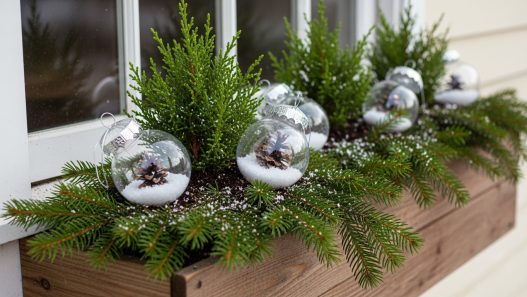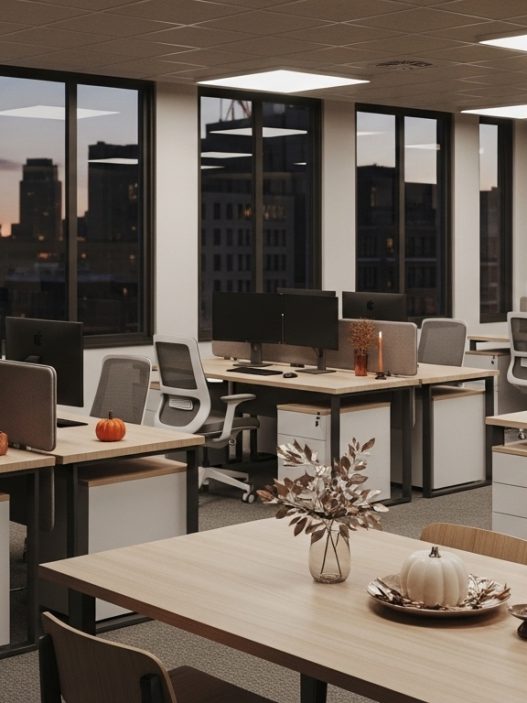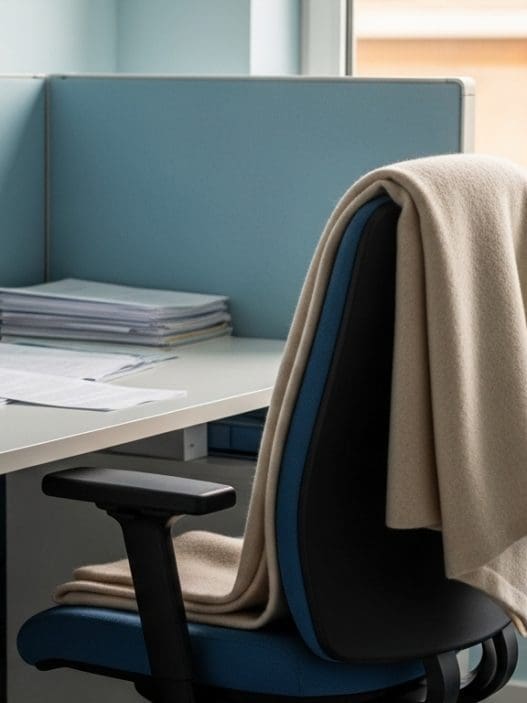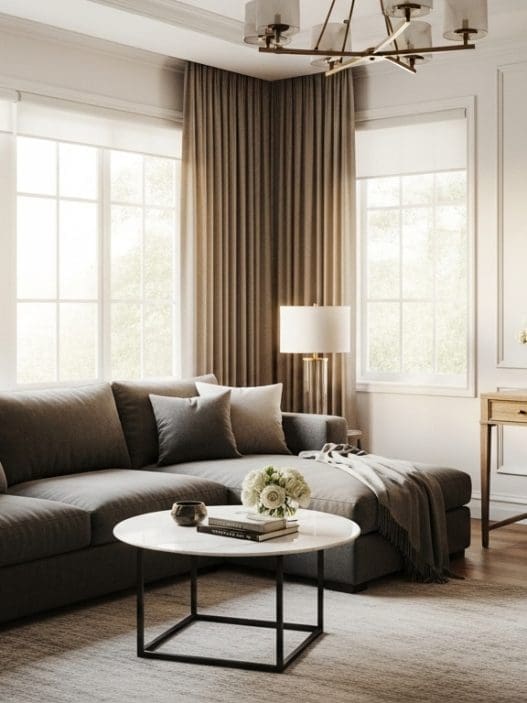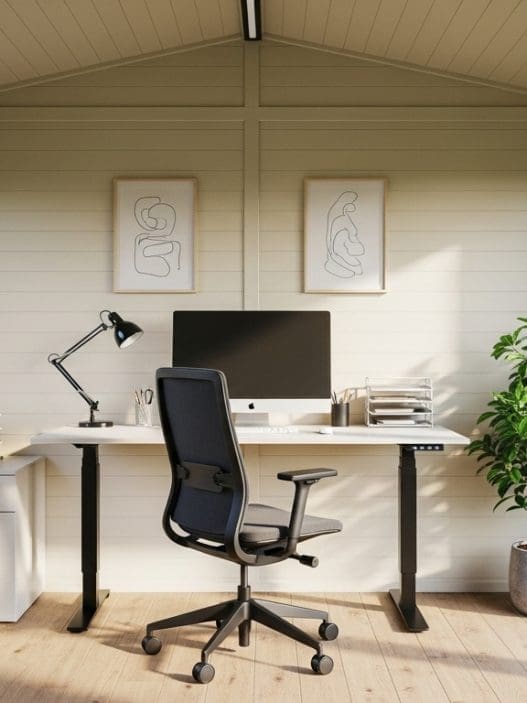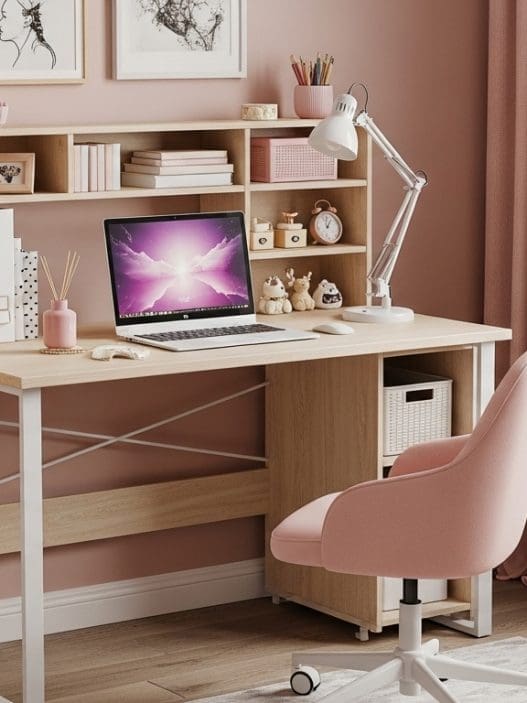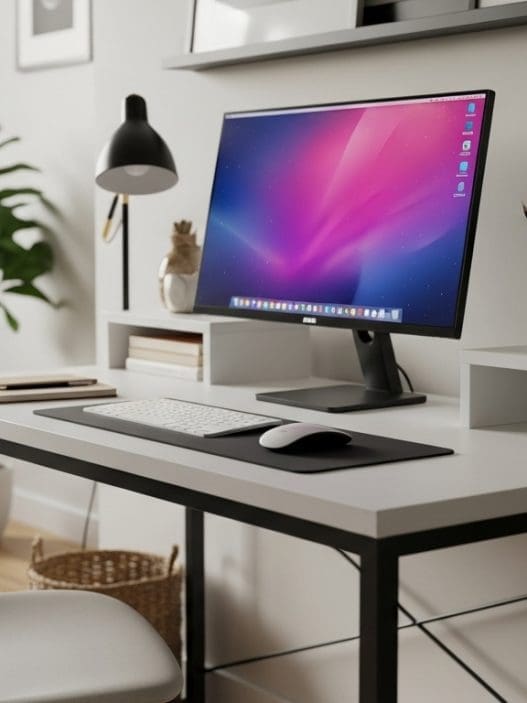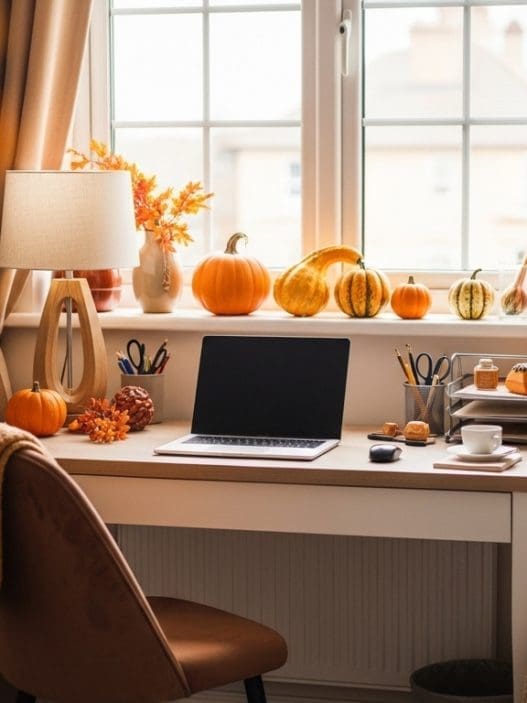Creating a homeschool space that feels both functional and welcoming doesn’t have to be overwhelming. I’ve spent countless mornings sipping coffee while setting up little corners for learning, and one thing I’ve learned is that even small touches make a huge difference. From calming colors to clever storage hacks, the right environment can transform home school room learning from a chore into something your kids look forward to.
Even if you don’t have a spare room, you can carve out a productive corner in a bedroom, living room, or even a hallway nook. Soft lighting, tactile textures, and organized supplies all help keep the space inviting while supporting focus.
How to Make the Most Out of a Homeschool Space
Even a small corner can feel like a full classroom with the right setup. Start by clearly defining zones for different activities, desk work, reading, and creative projects, so your child knows where to focus.
I love adding a soft rug under the desk and a small beanbag in a reading corner; it subtly signals where each activity belongs.
Keep supplies within reach in labeled baskets or jars, so kids can grab what they need without interrupting your flow.
Use vertical space too, such as wall shelves or corkboards, to store books and display work without taking up precious floor space.
Lighting is also key: Natural light energizes the room, and layered lamps create a cozy glow for afternoon study.
Finally, incorporate small personal touches like favorite prints, small plants, or a whimsical clock to make the space feel inviting and truly theirs.
What to Do If You Don’t Have a Dedicated Room for Homeschooling
No spare room? No problem.
Even a corner of the living room, dining area, or bedroom can transform into a functional learning zone.
I always use rugs or room dividers to visually separate the homeschool area from daily life, it makes the space feel intentional.
Rolling carts or bins on wheels are lifesavers for moving supplies in and out when you need the space for other purposes.
Multi-use furniture, like a foldable desk or a small table that doubles as an art station, keeps the room flexible.
Personal touches, like a favorite cushion or framed artwork, help the area feel like a special nook rather than an afterthought.
Clear routines and a consistent setup each morning also help children mentally shift into “learning mode” even without walls to define the space.
What Not to Do in Homeschooling Decor
It’s easy to overdo it when creating a homeschool space.
Avoid cluttering walls and shelves with too many decorative items, this can make the area visually overwhelming and distract children from learning.
Don’t mix too many color schemes or textures, as this can feel chaotic rather than cozy.
Overly bright or harsh lighting can strain the eyes and create a stressful atmosphere, so keep it soft and balanced.
Avoid setting up the learning space in high-traffic or noisy areas, as constant distractions make focus difficult.
Finally, don’t skip functional organization for aesthetics, pretty bins and decor are wonderful, but if supplies aren’t easy to access or tidy up, the space quickly becomes frustrating for both you and your kids.
23 Home School Decor Ideas
Below I’m sharing 23 home school room ideas that blend practicality with a cozy, approachable vibe.
1. Designate a Specific Learning Zone
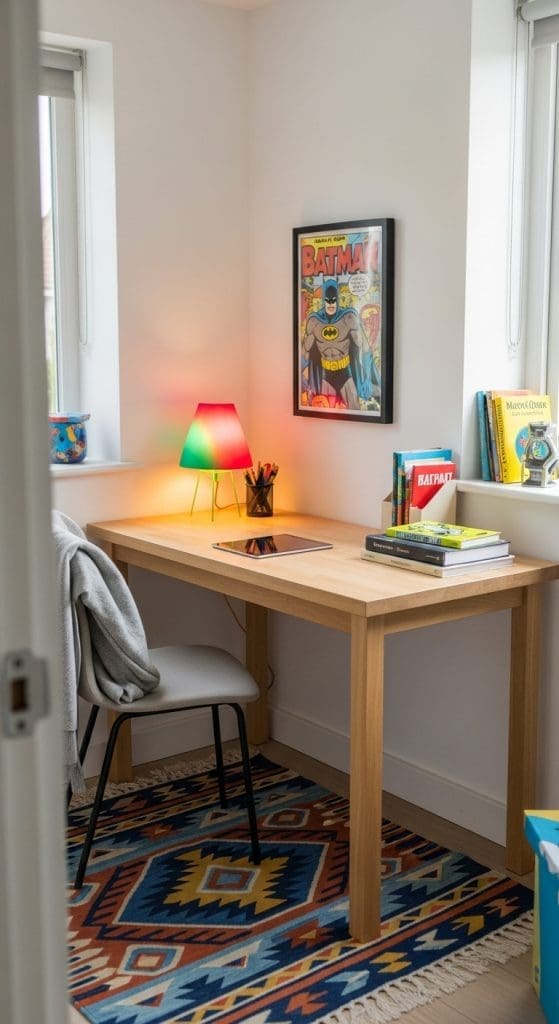
Creating a dedicated learning area helps children understand that this space is for focus and study, not play.
I always place a small rug under the desk so the zone feels special and visually separate from the rest of the room.
Adding a colorful lamp or a favorite wall print makes the area feel inviting rather than clinical. Even if your space is small, using a corner or nook signals to your child that it’s time to switch into “learning mode.”
I like keeping only essential supplies on the desk to reduce distractions, but a few personal touches, like a tiny plant or a photo, make it cozy and inspiring. Over time, kids naturally gravitate toward this spot, creating a habit of settling in and focusing without constant reminders.
2. Choose Soft, Calming Colors
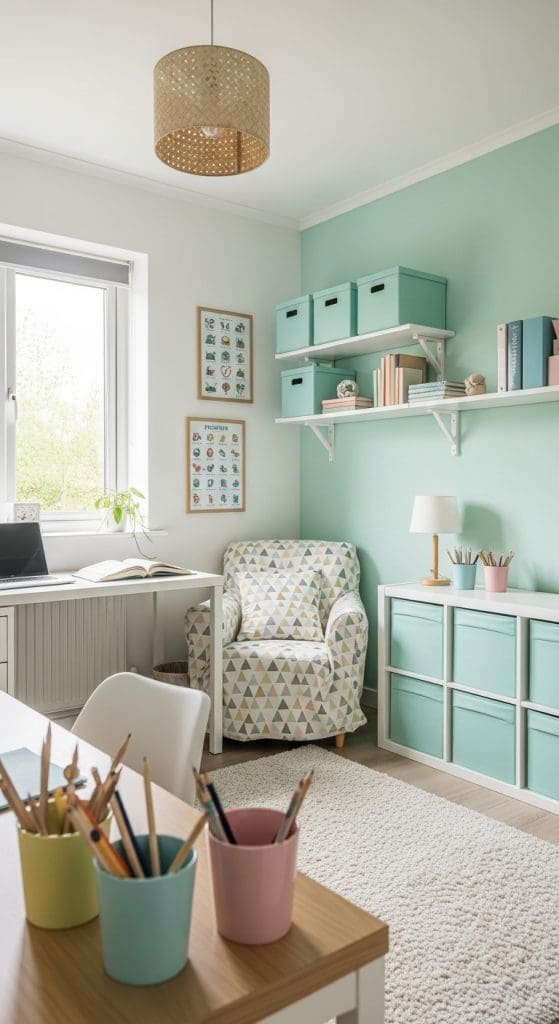
Pale blues, muted greens, or soft blush tones reduce visual clutter and create a serene environment.
I painted one wall a gentle mint and paired it with matching storage bins, and suddenly the room felt lighter and more inviting.
Even small accessories like pastel pencil cups or patterned cushion covers can reinforce a calming palette. These hues encourage concentration and make the space feel more intentional instead of chaotic.
Adding subtle textures, like a woven rug or linen curtains, also balances the color and keeps the room cozy. Soft colors naturally help children transition into a learning mindset without feeling overwhelmed by bright or bold tones.
3. Incorporate a Reading Nook
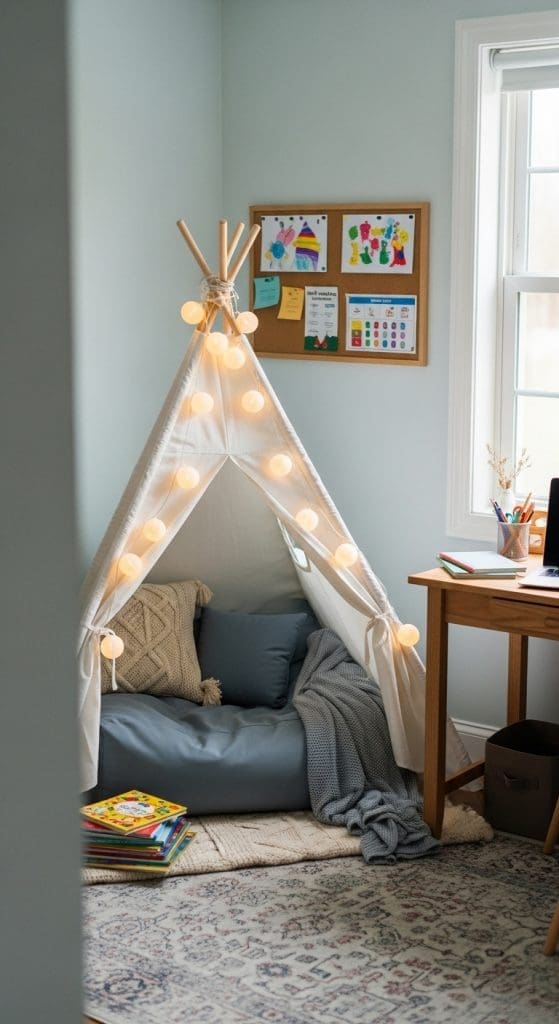
A comfy reading corner in a home school room encourages independent exploration and provides a break from the desk.
I added a small tent draped with string lights and a beanbag chair, and my kids instantly claimed it as their favorite spot.
A basket of age-appropriate books within arm’s reach makes reading feel easy and fun, while a soft throw adds warmth and texture.
Even a small window seat works as a perfect nook, giving kids a cozy spot to curl up with a story.
Rotating the books seasonally keeps the area fresh and interesting, and a few plush pillows make it inviting for longer reading sessions.
4. Use Open Shelving for Supplies
Open shelves in a home school room allow children to see their supplies at a glance, which reduces time spent searching and encourages independence.
I like using wicker baskets to hold pencils, markers, and notebooks because the natural texture softens the look of the shelving.
Keeping items grouped by type or color adds a sense of order and makes cleanup easier. You can also display small decorative items like framed artwork or a clock to make the shelves feel personal rather than purely functional.
Open shelving teaches kids to maintain organization, and the tactile elements like baskets or jars make reaching for supplies satisfying and fun.
Over time, children learn to respect their space while still having everything accessible.
5. Personalize Their Space
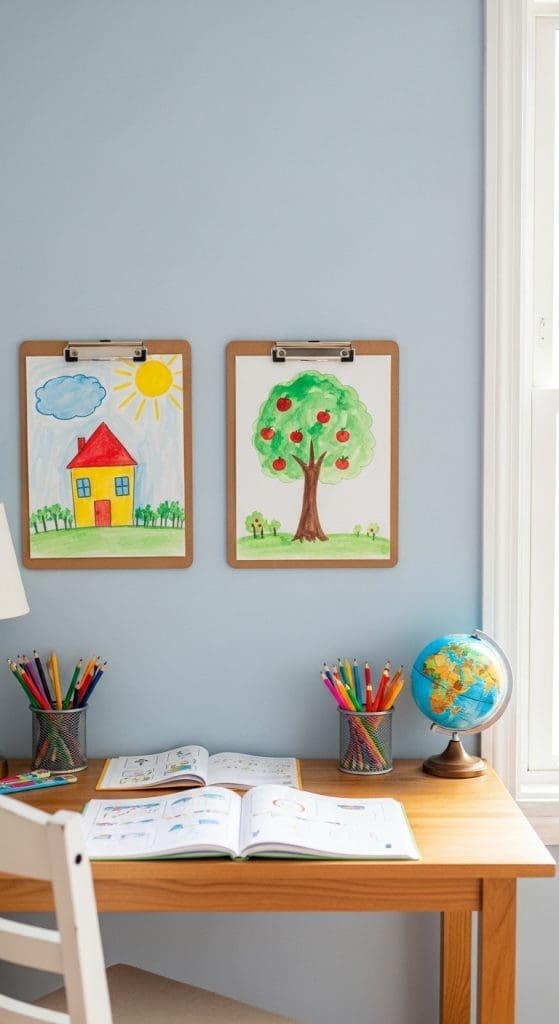
Adding personal touches in a home school room transforms a generic room into a place your child feels ownership over.
I framed my sons watercolor paintings and pinned them to clipboards above his desk, instantly brightening the wall and making the space feel meaningful.
Name signs, inspirational quotes, or favorite characters also help kids feel invested in their learning environment.
Even small items, like a favorite mug holding pencils or a fun lamp, make the area feel uniquely theirs.
Personalization encourages kids to care for the space, tidy up on their own, and enjoy spending time there.
The combination of functional furniture and personal accents creates a balance between learning and comfort.
6. Add a Large Desk or Table Surface
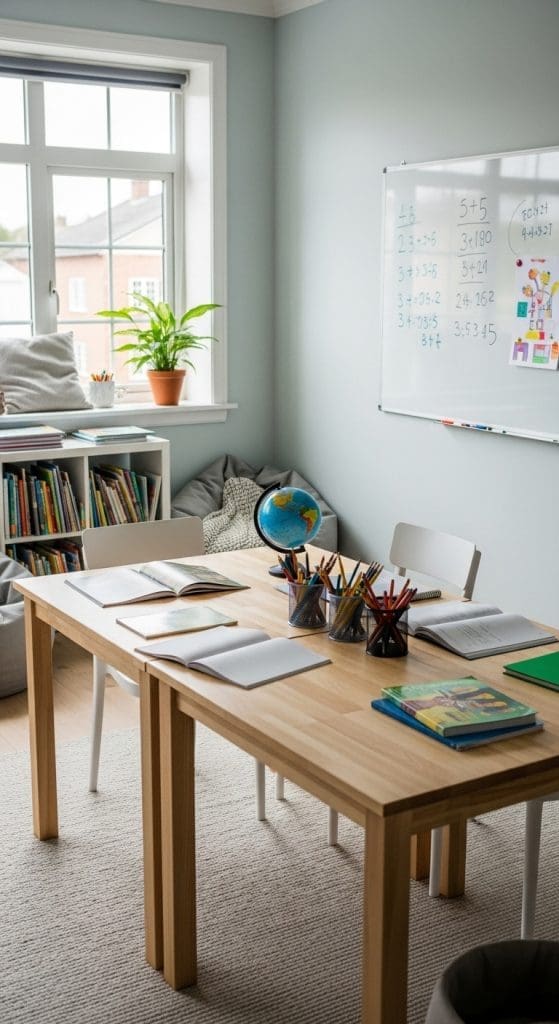
A roomy desk in a home school room allows children to spread out books, papers, and craft materials comfortably, reducing frustration and creating a better work flow.
I use a light wood table that accommodates two children side by side, giving them space to work independently while still feeling connected.
The smooth surface makes writing and drawing effortless, and adding a few desk organizers keeps materials tidy. A bigger surface also allows for hands-on projects or experiments without constantly needing to clear space.
Paired with a comfortable chair, it ensures kids can focus for longer periods without discomfort.
Over time, this encourages productive habits and makes homework feel more manageable.
7. Layer in Textures
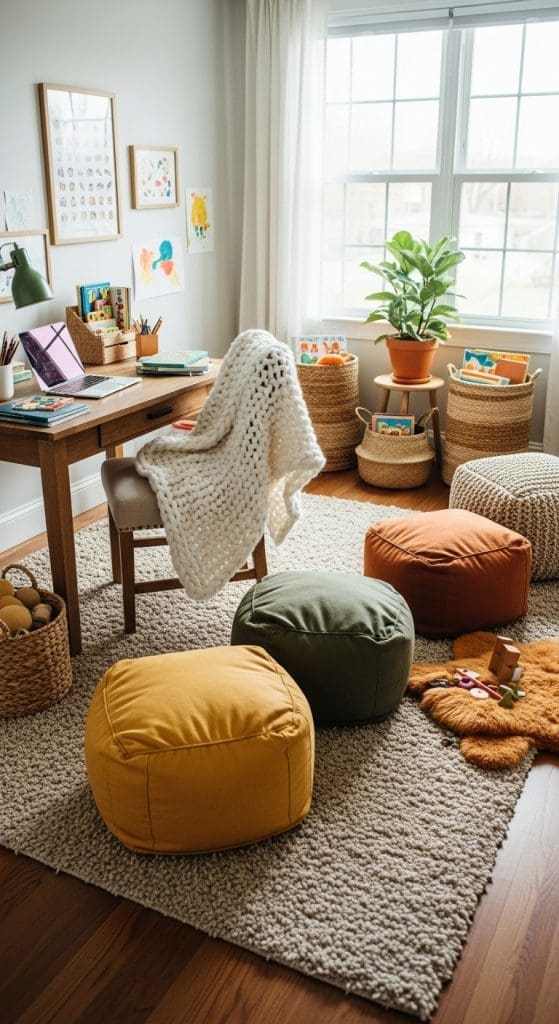
Incorporating soft textures balances the harder surfaces of desks and chairs, making the room feel warm and approachable.
I draped a chunky knit throw over the back of a chair and added a plush rug underfoot, creating a tactile experience that invites kids to linger.
Cushions, floor poufs, or woven baskets add visual interest and comfort while still serving practical purposes.
Mixing smooth, rough, and soft textures keeps the environment dynamic and cozy.
These subtle sensory cues make the room feel intentional and cared for, which encourages children to enjoy learning there. Textures also help define zones, like a rug under the desk or pillows in the reading nook.
8. Install a Chalkboard or Whiteboard Wall
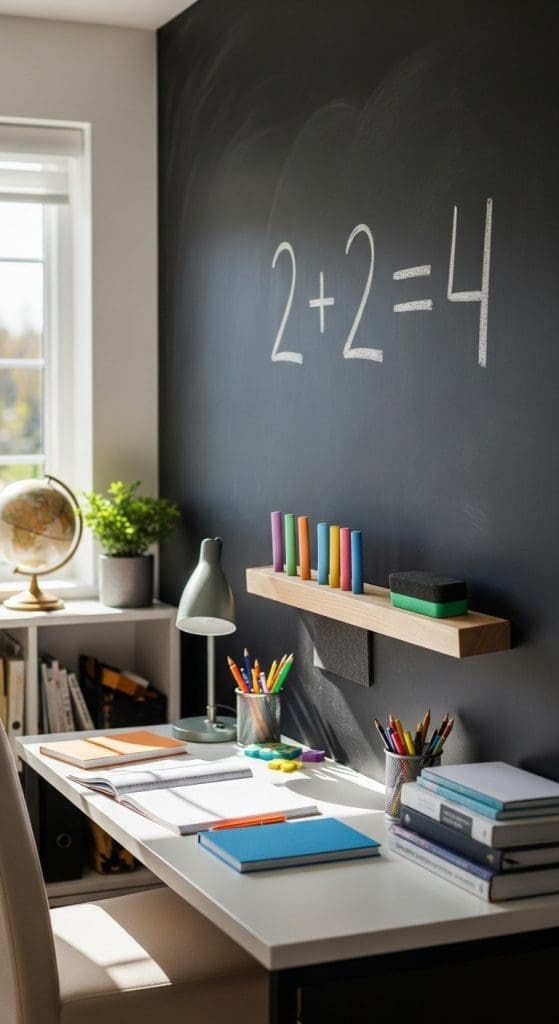
A writable wall in a home school room gives kids a space to brainstorm, practice writing, or visualize ideas.
A friend painted one wall with chalkboard paint and added a small ledge for chalk and erasers, making math practice or drawing interactive and fun.
The tactile act of writing on a wall rather than paper adds novelty and excitement.
You can rotate activities, using it for schedules, learning games, or spontaneous doodles.
Even older children appreciate having a larger space to map out projects or timelines.
Adding a few magnetic elements or clips can expand functionality without cluttering the floor. The writable wall naturally encourages creativity while keeping learning materials contained.
9. Keep Supplies Within Reach
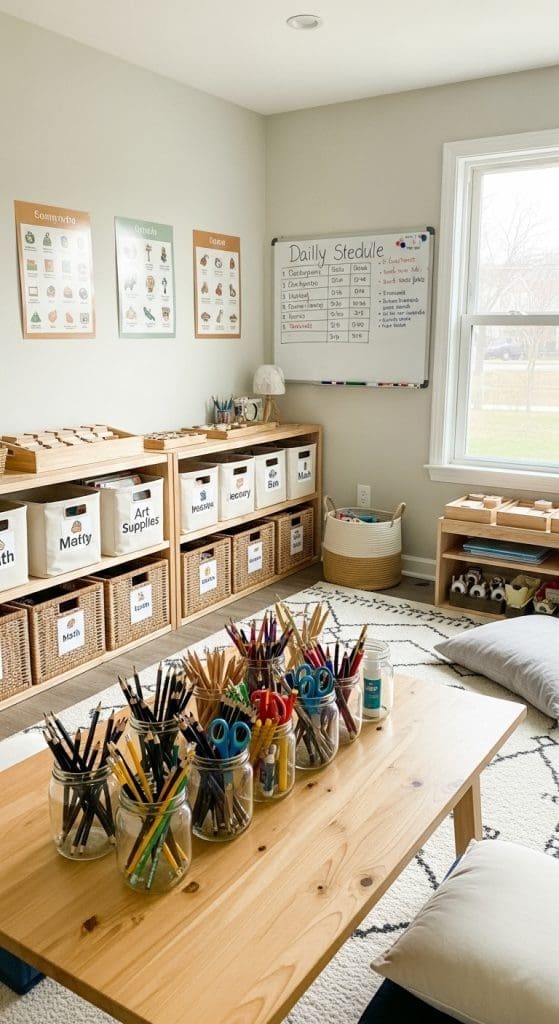
Low shelves or labeled bins allow children to access what they need independently, fostering responsibility.
I keep pencils, scissors, glue sticks, and paper in clear jars at kid height, which reduces interruptions during lessons.
Sorting materials by type also teaches kids organization skills naturally. Colorful labels or simple illustrations make it easier for younger children to know where everything belongs.
When supplies are easy to reach, kids feel empowered to manage their own projects, which builds confidence.
This small adjustment prevents frustration and helps maintain a tidy, functional learning space.
10. Bring in Natural Light
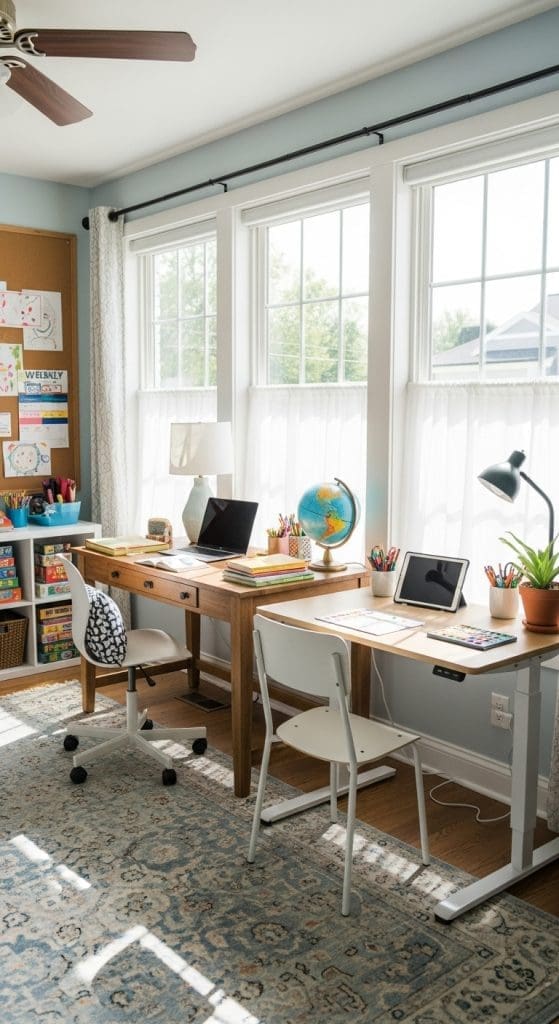
Positioning desks or workstations near windows brings in daylight, which energizes children and improves focus.
I love the morning sun spilling across my son’s workspace, it makes the room feel airy and cheerful.
Natural light reduces the need for harsh overhead lighting and helps maintain a pleasant, balanced mood throughout the day.
Adding lightweight curtains or blinds lets you control glare while keeping brightness consistent.
Even small window-side desks benefit from the view and subtle connection to the outdoors.
Exposure to daylight naturally supports attention, making learning feel less like a chore and more like a daily ritual.
11. Add a Corkboard or Inspiration Wall
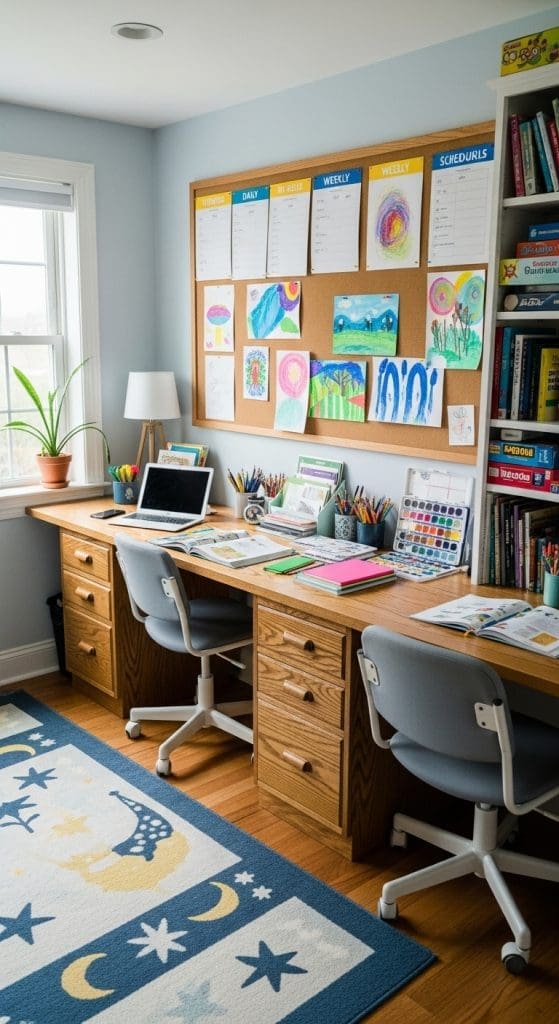
A corkboard or pin wall gives kids a space to display schedules, artwork, or motivational quotes.
I love the idea of adding a simple wooden corkboard above a desk and rotating drawings and colorful index cards every week. It keeps the space dynamic and personal while helping them visualize goals.
Adding small clips, pushpins, or washi tape brings a fun, tactile element that children enjoy interacting with.
It also encourages responsibility, as kids learn to keep their wall neat and up to date.
Seeing their accomplishments on display boosts confidence and makes the room feel lively and motivating. Even a small section of wall works wonders for personalization and organization.
12. Create a Technology Corner
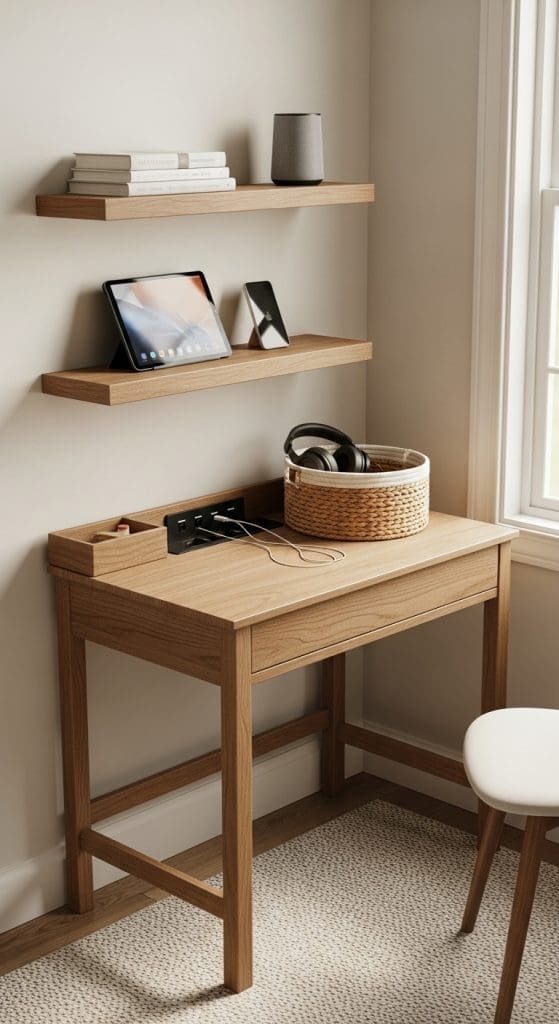
If your homeschool routine includes tablets or computers, a dedicated technology zone keeps digital learning organized.
I set up a small corner with a charging station, a basket for headphones, and a couple of shelves for devices.
This prevents electronics from cluttering the main desk and creates a sense of separation between screen time and offline tasks. Labeling cords and adding cable organizers reduces frustration and teaches kids to manage their own setup.
The corner can also be decorated with a fun poster or colorful accessories so it feels inviting, not purely functional.
Over time, children learn to respect boundaries and focus better when using devices.
13. Use Rolling Carts for Flexibility

Rolling carts are a lifesaver for keeping supplies mobile and accessible.
I keep one for art materials, another for science experiments, and wheel them wherever we need extra space.
The kids love being able to push the cart themselves, which adds a playful element while teaching independence.
Rolling carts also make cleanup a breeze, everything returns to its place in seconds.
You can add baskets or small containers to keep items separated and visually appealing.
Even a small three-tier cart can hold pencils, paints, and paper, making it a versatile solution for small spaces. Flexibility ensures that the homeschool area adapts to different projects or group activities easily.
14. Hang Shelves for Books

Wall-mounted shelves free up floor space while keeping books and educational materials accessible.
I installed a few floating shelves above the desk and mix storage baskets with displayed books, giving the room a tidy, organized look.
Kids can easily see what’s available and choose their own reading materials, fostering independence.
Mixing in small decorative items like framed photos or a mini plant adds warmth and personality.
Vertical storage maximizes space in smaller rooms and keeps floors uncluttered for other activities.
A combination of low and high shelves lets children reach their own materials while keeping breakable items safely out of reach. Rotating books seasonally keeps the display fresh and engaging.
15. Introduce Plants
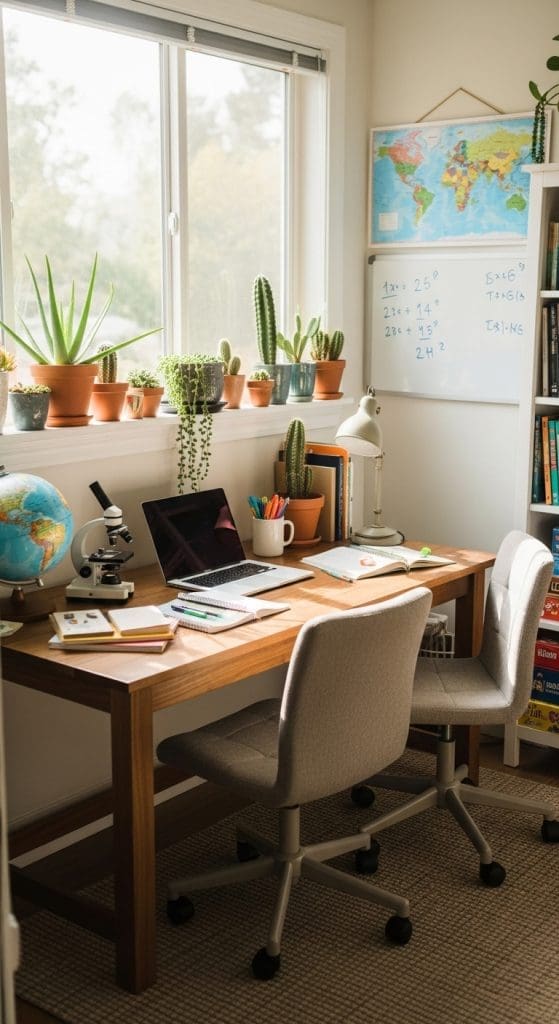
Adding greenery brings life and energy to a homeschool room.
I like placing low-maintenance potted plants or succulents on windowsills or shelves, which adds color and texture.
Plants naturally improve air quality and provide a subtle, calming effect that helps children focus.
Kids enjoy watering and caring for the plants, which introduces a small element of responsibility.
Even a tiny herb garden on a desk doubles as a science lesson about growth and sunlight.
Pairing plants with natural textures, like wicker baskets or clay pots, enhances the room’s cozy, inviting feel. The presence of greenery makes the space feel fresh, lively, and balanced.
16. Incorporate a Comfortable Chair
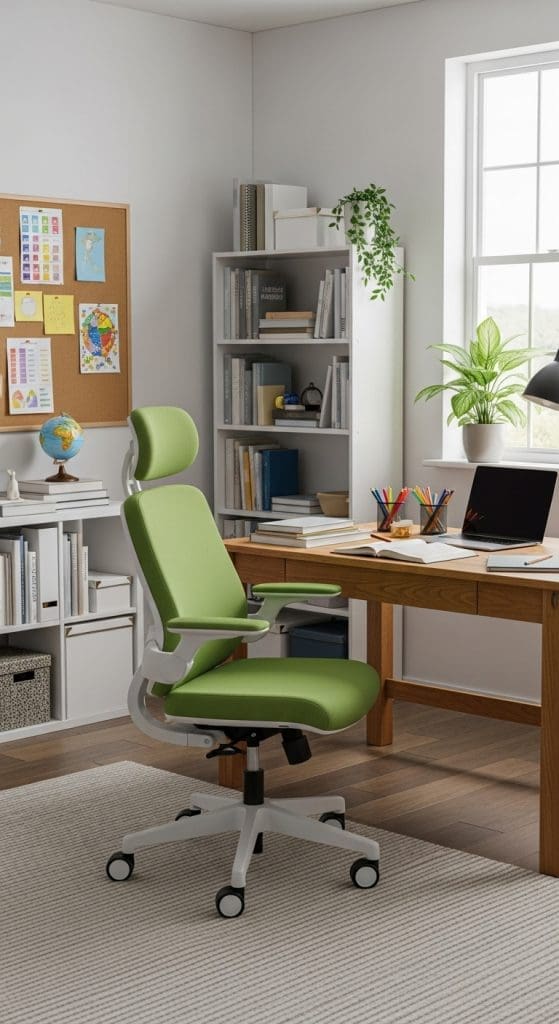
A supportive chair is essential for focus during longer learning sessions.
I chose a cushioned swivel chair for my son and noticed instantly that he could work more comfortably for longer periods.
Ergonomic support reduces fatigue, while a soft seat makes the space inviting.
Even adding a small pillow or lumbar cushion increases comfort and encourages proper posture.
A cozy chair in a reading or technology corner also creates a dual-purpose spot for work and relaxation.
Children feel more motivated to sit and complete tasks when the seating is both functional and pleasant.
Selecting a chair with adjustable features allows it to grow with your child.
17. Use Soft Rugs to Define Zones

Rugs help differentiate areas for desk work, reading, or play in a home school room.
I layered a patterned rug under the main desk and a plush shag rug in the reading nook, making the room feel visually organized.
Rugs also provide a cozy tactile element underfoot, softening hard floors and adding warmth.
They help anchor furniture in smaller spaces and make the room feel intentional rather than randomly arranged.
Choosing colors and textures that complement the walls and furnishings enhances the overall mood.
Even inexpensive rugs can make a corner feel like a special retreat.
Defined zones help children mentally shift between different activities throughout the day.
18. Add Hooks for Bags and Jackets

Wall hooks are a simple solution for keeping backpacks and coats off the floor.
I installed colorful hooks at kid height, so children can hang their items independently.
This reduces clutter, keeps pathways clear, and teaches organizational skills without nagging.
Hooks can also hold aprons, hats, or even artwork, adding versatility.
Using decorative hooks adds personality and keeps the space visually interesting.
Over time, kids develop the habit of returning items to their proper place, which makes cleanup routines smoother. A small row of hooks creates a tidy, functional corner in even the smallest homeschool spaces.
19. Incorporate Fun Lighting

Lighting sets the mood for productivity and comfort in a home school room.
I mixed a soft-glow desk lamp with string lights above the reading nook, which adds warmth and visual interest.
Layered lighting reduces eye strain during tasks and creates cozy corners for independent reading.
Fun lighting options, like clip-on lamps or adjustable LEDs, make it easier to customize brightness for different activities.
Children respond positively to inviting, well-lit spaces, which encourages focus.
Even inexpensive lights can create a charming ambiance that feels intentional and thoughtful. Proper lighting enhances both aesthetics and functionality in a homeschool room.
20. Keep a Timer or Clock Visible
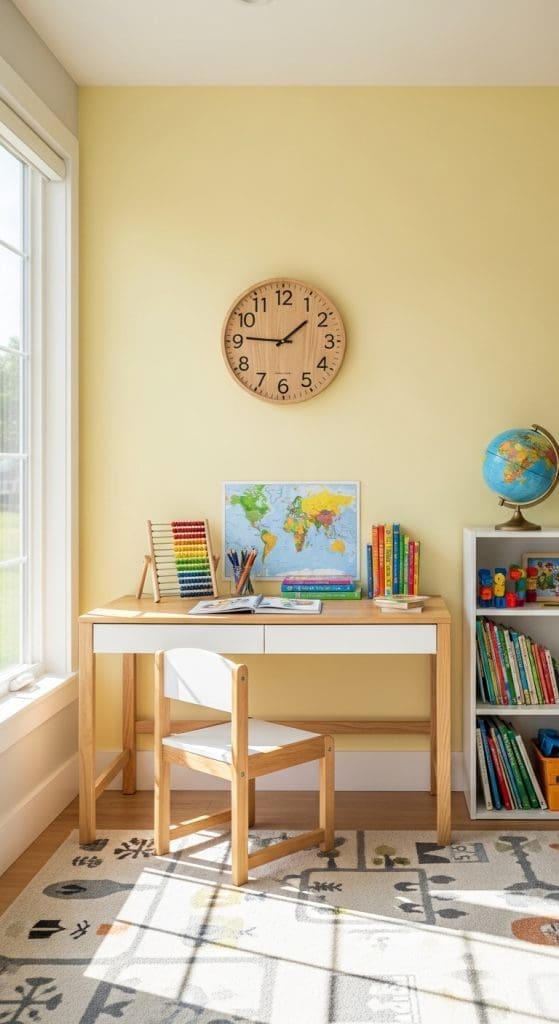
A wall clock or timer in a home school room helps children manage time and develop independence.
I placed a simple wooden clock above the desk, making it easy for my kids to check progress without asking me constantly.
Using a timer for tasks teaches time management and reduces procrastination.
Visual cues help children pace themselves, whether for reading, math, or creative projects.
Adding a digital timer with a fun color or shape can make timing more engaging for younger learners.
Over time, kids develop self-discipline and learn to structure their own work sessions. A visible timepiece creates a subtle sense of routine and rhythm in the space.
21. Provide Adjustable Seating
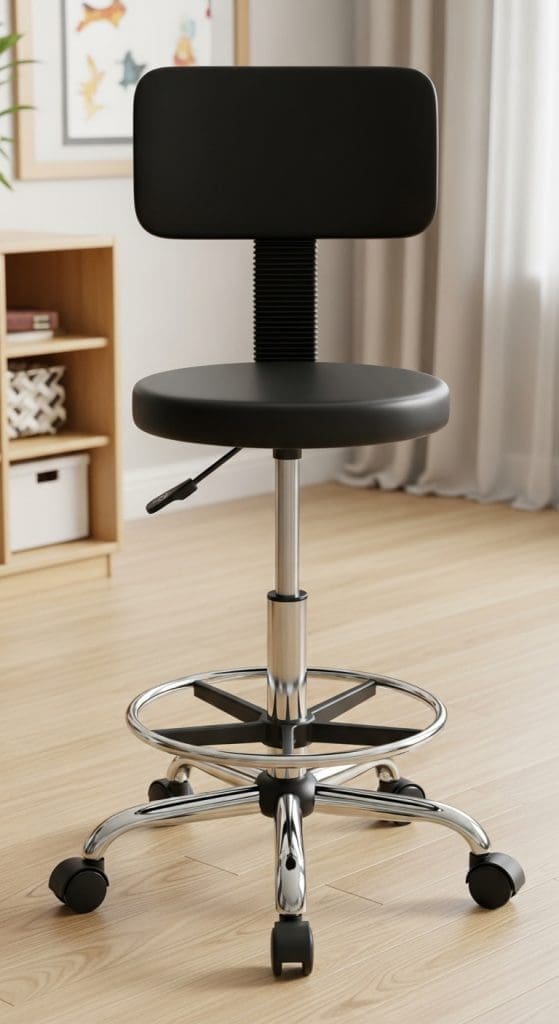
Adjustable chairs or floor cushions accommodate growing children and different activities.
I swapped one chair for a height-adjustable stool, which made drawing, writing, and tabletop experiments much more comfortable.
Cushions on the floor or window seat also give flexible seating options.
Adjustable seating allows kids to sit comfortably at the correct height for their desk, preventing slouching and discomfort.
The ability to shift positions supports both focus and relaxation during lessons.
Including a mix of chairs, stools, and soft seating gives children choice and control over their learning environment.
22. Add a Small Table for Group Work
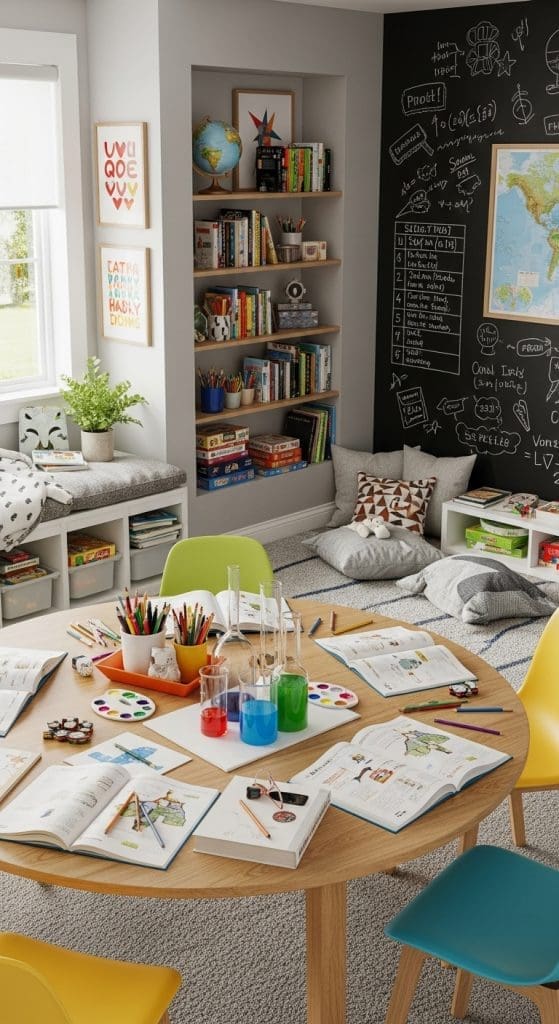
A secondary table in a home school room encourages collaboration when siblings or friends learn together.
I keep a round table in a corner for shared projects, games, or experiments, separate from independent desk work.
This distinction helps children switch between teamwork and solo focus. Adding small chairs or floor cushions ensures everyone is comfortable and engaged.
Group tables also foster communication, problem-solving, and social learning naturally.
By creating a separate, inviting space, kids learn to cooperate while keeping the main desk clear for individual tasks. The table becomes a flexible hub for creativity and connection.
23. Keep a Cozy Throw Blanket Handy

Even small touches in a home school room like a soft blanket make the room feel inviting and comforting.
I keep a chunky knit throw folded neatly in the reading nook, and my children instinctively reach for it when settling in for quiet reading or taking a break.
A cozy blanket adds warmth, texture, and a tactile cue that this is a place for calm focus.
It can also make less structured moments, like storytelling or brainstorming, feel special and relaxing.
Pairing it with cushions and soft rugs enhances the overall comfort of the space.
Little details like a throw can transform a functional room into a nurturing, enjoyable learning environment.





